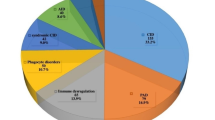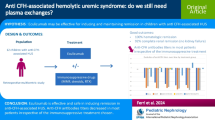Abstract
Objective: The incidence and the risk factors of sickle cell disease (SCD), vaccinated with Pneumococcal vaccine and on penicillin prophylaxis has not been previously reported in India.Methods: This prospective hospital based study followed 325 children on penicillin prophylaxis, of which 161 were vaccinated for pneumococci, over 146.84 person years to determine the incidence and determinants of crisis (SCC) and infections. The average age at presentation was 7.05 ± 3.26 years with male preponderance below 2 years.Results: The main causes for hospitalizations were for blood transfusion, SCC and infections. The incidence of SCC was 1.25 per patient per year and that of infection was 1.38 per person per year. The risk factors for SCC were Mahar caste (p = 0.007) non-compliance (p = 0.000) and protein energy malnutrition (PEM) (p = 0.0015) and for infection were also PEM (p = 0.023), Mahar caste (p = 0.021) and noncompliance (p = 0.001).Conclusion: Malnutrition and non-compliance with medication increased the patient’s susceptibility to SCC and infections.
Similar content being viewed by others
References
Gupta VL, Dube GK, Choubey BS. Sickle cell anemia, clinical profile in central India, Nagpur.J Acad Med Sciences 1981; 1: 5.
Kamble M, Chaturvedi P. Epidemiology of sickle cell disease in a rural hospital in Central India.Indian Pediatr 2000; 37: 391–396.
Samuels-Reid JH Common problems in sickle cell disease.Am Fam Physician 1994; 49(6): 1477–1480,1483–1486.
Begue P.Pathol Bid Infection and Sickle Cell Anemia. (Paris) 1999 47(1): 19–25.
Onwubalili JK. Sickle cell disease and infection.J Infect 1983; 7(1): 2–20.
El-Hazmi MA, Warsy AS, Bashir N, Beshlawi A, Hussain IR, Temtamy S, Qubaili F. Haplotypes of the beta-globin gene as prognostic factors in sickle-cell disease. East Mediterr Health J 1999; 5(6): 1154–1158.
Kulozik AE, Kar BC, Satapathy RKet al. Fetal hemoglobin levels and βJ-globin haplotypes in Indian population with sickle cell disease.Blood 1987; 69: 1742.
Serjeant GR. Natural history and determinants of clinical severity of sickle cell disease.Curr Opin Hematol 1995; 2(2): 103–108.
Markowite M, Gordis LA. A mail in technique for detecting penicillin in urine: application to the study of maintenance of prophylaxis in rheumatic fever patients.Pediatric 1968; 41: 151–153.
Tshilolo L, Mukendi R, Girot R. Sickle cell anemia in the south of Zaire. Study of two series of 251 and 340 patients followed-up 1988–1992.Arch Pediatr 1996; 3(2): 104–111.
Fleming AF. The presentation, management and prevention of crisis in sickle cell disease in Africa.Blood Rev 1989; 3(1): 18–28
Kulozik AE, Thein SL, Kar BC, Wainscoat JS, Serjeant GR, Weatherall DJ. Raised Hb F levels in sickle cell disease are caused by a determinant linked toThe beta globin gene cluster.Prog Clin Biol Res 1987; 251: 427–439.’
Kapur D, Agarwal KN, Agarwai DK. Nutritional anemia and its control.Indian J Pediatr 2002; 69(7): 607–616.
Kotila TR, Shokunbi WA. Survival advantage in female patients with sickle cell anemia.East Afr Med J 2001; 78(7): 373–375.
Falusi AG, Esan GJ. Foetal hemoglobin levels in sickle cell anaemia in Nigerians.AfrJ Med Med Sci 1989; 18(2): 145–149.
Dover GJ, Smith KD, Chang YC, Parvis S, Mays S, Meyers Det al. Fetal hemoglobin levels in sickle cell disease and normal individuals are partially controlled by an X-linked gene located at xp 22.2.Blood 1992; 80: 816–824.
Adekile McKie KM, Adeodu OO, Sulzer AJ, Liu JS, McKie VC, Kutlar Fet al. Spleen in sickle cell anemia: comparative studies of Nigerian and U.S. patients.Am J Hematol 1993; 42(3): 316–321.
Serjeant GR, Ceulaer CD, Lethbridge R, Morris J, Singhal A, Thomas PW. The painful crisis of homozygous sickle cell disease: clinical features.BrJHaematal 1994, 87(3): 586–591.
Francis RB Jr, Haywood LJ. Elevated immunoreactive tumor necrosis factor and interleukin-1 in sickle cell disease.J Natl Med Assoc 1992; 84(7): 611–615.
Singhal A, Parker S, Linsell L, Serjeant G. Energy intake and resting metabolic rate in preschool Jarnaican children with homozygous sickle cell disease.Am J Clin Nutr 2002; 75(6): 1093–1097.
Barden EM, Zemel BS, Kawchak DA, Goran MI, Ohene-Frempong K, Stallings VA. Total and resting energy expenditure in children with sickle cell disease.J Pediatr 2000; 136(1): 73–79.
Daly JM, Reynolds J, Sigal RK, Shou J, Liberman MD. Effect of dietary protein and amino acids on immune function.Crit Care Med 1990; 18(2 Suppl): S86-S93.
Nezu R, Nakahara K. Role of malnutrition on immunityNippon Rinsho 1994; 52(2): 410–414.
Begue P. Infection and sickle cell anemia.Pathol Biol (Paris) 1999; 47(1): 19–25.
Kaul DK, Fabry ME, Nagel RL. Vaso-occlusion by sickle cells: evidence for selective trapping of dense red cells.Blood 1986; 68(5): 1162–1166.
Shartava A, Mclntyre J, Shah AK, Goodman SR. The Gardos channel is responsible for CDNB-induced dense sickle cell formation.AmJHematol 2000; 64(3): 184–189.
Shartava A, Shah AK, Goodman SR. N-acetylcysteine and clotrimazole inhibit sickle erythrocyte dehydration induced by l-chloro-2,4-dinitrobenzene.Am J Hematol 1999; 62(1): 19–24.
Reid M, Badaloo A, Forrester T, Morlese JF, Frazer M, Heird WC, Jahoor F. In vivo rates of erythrocyte Glutathione synthesis in children with severe protein-energy malnutrition.Am J Physiol Endocrinol Metab 2000; 278(3): E405-E412.
Tatli MM, Vural H, Koc A, Kosecik M, Atas A. Altered antioxidant status and increased lipid peroxidation in marasmic children.Pediatr Int 2000; 42(3): 289,292.
Elliott V, Morgan S, Day S, Mollerup LS, Wang W. Parental health beliefs and compliance with prophylactic penicillin administration in children with sickle cell disease.J Pediatr Hematol Oncol 2001; 23(2): 112–116.
Cummins D, Heuschkel R, Davies SG. Penicillin prophylaxis in children with sickle cell disease in Brent.,BMJ 1991; 302(6783): 989–990.
Author information
Authors and Affiliations
Corresponding author
Rights and permissions
About this article
Cite this article
Patel, A.B., Athavale, A.M. Sickle cell disease in central India. Indian J Pediatr 71, 789–793 (2004). https://doi.org/10.1007/BF02730713
Issue Date:
DOI: https://doi.org/10.1007/BF02730713




